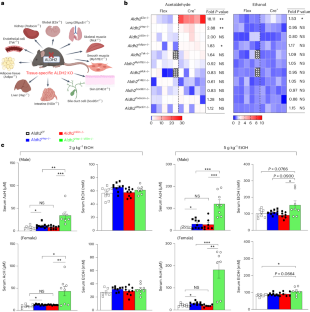肠道-肝脏途径的协调作用推动酒精解毒和消费
IF 18.9
1区 医学
Q1 ENDOCRINOLOGY & METABOLISM
引用次数: 0
摘要
酒精使用障碍(AUD)影响着全球数百万人,造成了广泛的发病率和死亡率,但药物治疗效果有限。肝脏被认为是醛脱氢酶 2(ALDH2)对乙醇代谢物乙醛(Acaldehyde,ACH)进行解毒的主要部位,也是治疗酒精中毒性口腔炎(AUD)的靶点,然而,我们最近的数据表明,肝脏在清除全身性乙醛中只发挥了部分作用。在这里,我们发现肝脏-肠道轴(而非仅仅是肝脏)协同推动了全身性乙酰胆碱清除和自愿饮酒。从机理上讲,我们发现摄入乙醇后,肝脏中产生的大部分 AcH 会通过胆汁排泄到胃肠道,在那里 AcH 会被肠道中的 ALDH2 进一步代谢。调节胆汁流量可明显影响血清 AcH 水平和饮酒行为。因此,联合靶向肝脏和肠道 ALDH2 以及调节胆汁流量和分泌是治疗 AUD 的潜在治疗策略。本文章由计算机程序翻译,如有差异,请以英文原文为准。


Coordinated action of a gut–liver pathway drives alcohol detoxification and consumption
Alcohol use disorder (AUD) affects millions of people worldwide, causing extensive morbidity and mortality with limited pharmacological treatments. The liver is considered as the principal site for the detoxification of ethanol metabolite, acetaldehyde (AcH), by aldehyde dehydrogenase 2 (ALDH2) and as a target for AUD treatment, however, our recent data indicate that the liver only plays a partial role in clearing systemic AcH. Here we show that a liver–gut axis, rather than liver alone, synergistically drives systemic AcH clearance and voluntary alcohol drinking. Mechanistically, we find that after ethanol intake, a substantial proportion of AcH generated in the liver is excreted via the bile into the gastrointestinal tract where AcH is further metabolized by gut ALDH2. Modulating bile flow significantly affects serum AcH level and drinking behaviour. Thus, combined targeting of liver and gut ALDH2, and manipulation of bile flow and secretion are potential therapeutic strategies to treat AUD. Fu, Mackowiak et al. show that cooperative action of the liver and the gut, rather than the liver alone, drives acetaldehyde clearance after alcohol consumption and modulates drinking behaviour.
求助全文
通过发布文献求助,成功后即可免费获取论文全文。
去求助
来源期刊

Nature metabolism
ENDOCRINOLOGY & METABOLISM-
CiteScore
27.50
自引率
2.40%
发文量
170
期刊介绍:
Nature Metabolism is a peer-reviewed scientific journal that covers a broad range of topics in metabolism research. It aims to advance the understanding of metabolic and homeostatic processes at a cellular and physiological level. The journal publishes research from various fields, including fundamental cell biology, basic biomedical and translational research, and integrative physiology. It focuses on how cellular metabolism affects cellular function, the physiology and homeostasis of organs and tissues, and the regulation of organismal energy homeostasis. It also investigates the molecular pathophysiology of metabolic diseases such as diabetes and obesity, as well as their treatment. Nature Metabolism follows the standards of other Nature-branded journals, with a dedicated team of professional editors, rigorous peer-review process, high standards of copy-editing and production, swift publication, and editorial independence. The journal has a high impact factor, has a certain influence in the international area, and is deeply concerned and cited by the majority of scholars.
 求助内容:
求助内容: 应助结果提醒方式:
应助结果提醒方式:


